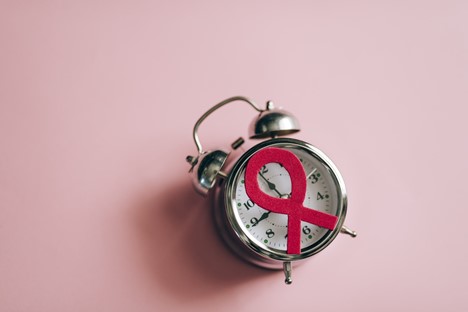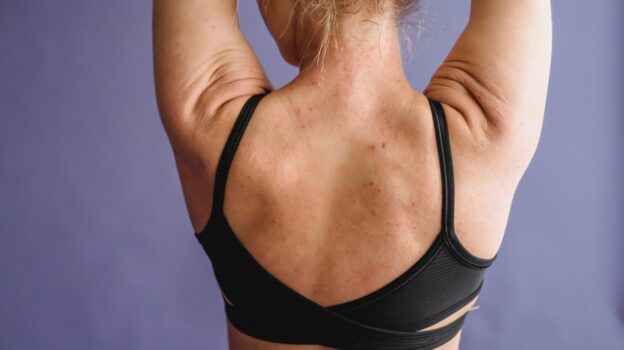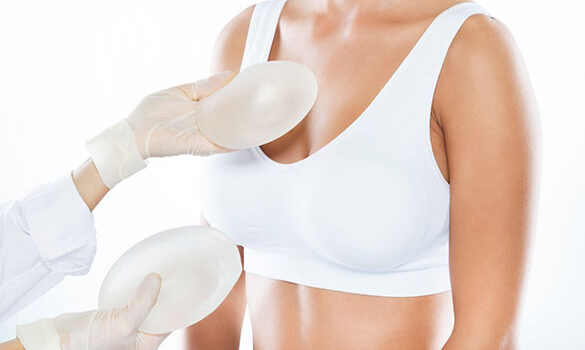There is a lot more to breast reconstruction than just the reconstruction, as there are various options, timelines, and emotions to take into consideration.
Typically, breast reconstruction takes place during or soon after a mastectomy procedure. Breast reconstruction also can be done many months or even years after a mastectomy. During breast reconstruction, a plastic surgeon creates a breast shape using an artificial implant (implant reconstruction), a flap of tissue from another place on your body (autologous reconstruction), or both.
At GraceMed, we offer breast reconstruction in Toronto, and specialize in additional breast surgeries including breast augmentation and breast lifts. When you work with GraceMed, you can have peace of mind knowing that we will be with you every step of the way to help you weight your options and guide you during the process.
In this post we will discuss the different types of breast reconstruction, timing of breast reconstruction, selecting your plastic surgeon, recovery, and alternatives to breast reconstruction.

What is Breast Reconstruction Surgery?
Breast reconstruction is a surgical procedure that restores the breast shape after a mastectomy – which is a surgery that removes the breast(s) to treat or prevent cancer. Breast reconstruction surgery is performed by a plastic surgeon.
If one breast is removed, the goal of the breast reconstruction surgery will be to recreate symmetry and match the remaining breast. If you have undergone a double-mastectomy, breast reconstruction surgery can be performed to recreate natural looking breasts that compliment your body.
Whatever your age, relationship status, sexual activity, or orientation, you can’t predict how you will react to losing a breast. It is normal to feel anxious, uncertain, sad, and mournful about giving up a part of your body. Moving forward, you can determine what you want to have happen next. However, it is important that you must do some careful thinking and delving into your feelings in order to figure out what is best for you.
Types of Breast Reconstruction:
There are different methods of breast reconstruction surgery that may be used. When considering breast reconstruction surgery, you will want to meet with a plastic surgeon for a consultation to discuss your desired breast reconstruction outcomes and together you will decide which method is best for you.
Breast Implants:
There are different types of breast implants that may be used for breast construction. Breast implants are silicone shells that are filled with either saline or silicone gel that are inserted under the skin or chest muscle to restore breast fullness. Breast implants come in numerous sizes and are round or teardrop in shape. Patients meet with their surgeon prior to their surgery to choose which implant shape and size they would like to have.
Your plastic surgeon may recommend tissue expansion which is a process that stretches the chest skin and soft tissue to help make room for the breast implant. The tissue expander is a balloon like implant that is placed over or under the chest muscle and can be placed at the time of the mastectomy or after.
Over the next few months, your doctor or nurse will fill the balloon-like expander in stages by using a small needle to inject saline into the expander. Gradually over time, the tissue expander will stretch the skin to the appropriate size required for the implant. Once the tissue expander has achieved the appropriate size, your surgeon will perform surgery to remove the expander and insert the permanent implant in its place.
Many women opt for breast implants following a mastectomy as they can achieve a desired size and shape that is specific to your aesthetic goals. Breast implants can help you achieve breast symmetry and restore your desired silhouette.
Autologous Breast Reconstruction:
Autologous breast reconstruction uses your own tissue, that is comprised of skin, fat, or muscle from another part of your body to recreate your breast shape. The donor sites can be your back, buttocks, thighs, and abdomen.
The tissue used in autologous breast reconstruction are either “free flap” or “pedicled flap”. A “free flap” is tissue that has been completely separated from the original blood vessel. While “pedicled flap” is tissue that is still connected to the original blood vessel. “Pedicled flap” is the most common method used in autologous breast reconstruction. Autologous breast reconstruction recreates very natural looking and behaving breasts. Because the breasts utilize your own tissue, they will respond to bodily changes such as gaining and losing weight.
Adjunctive Procedures That Compliment Breast Reconstruction:
After having your breast reconstruction surgery, you may wish to further enhance your results by adding additional procedures to compliment your breast reconstruction.
Nipple Reconstruction:
Following your breast reconstruction procedure, you may wish to add a nipple reconstruction procedure. Nipple reconstruction involves tattooing in pigments that compliment your skin tone to define the nipple and create the appearance of an areola.

Timing of Breast Reconstruction Surgery
Patients who have decided to pursue a breast reconstruction procedure have options for when they would like to have their breast reconstruction performed in relation to their mastectomy procedure.
The timing of breast reconstruction is one of the most discussed topics in reconstruction research. It’s important that your entire team of doctors including your breast surgeon, plastic surgeon, radiation oncologist, medical oncologist, and other caregivers meet as a group and discuss your unique situation. Ideally, this group should meet before you make your decision about mastectomy because the type of breast surgery you have can affect the reconstruction outcome.
Each breast cancer is unique; therefore, each breast reconstruction surgery and its timing are unique. Together, you and your team can decide on an approach that is best for you.
Immediate Breast Reconstruction
When a breast reconstruction surgery is performed at the same time as a mastectomy surgery, this is called immediate reconstruction. As soon as the breast is removed by the breast cancer surgeon, the plastic surgeon reconstructs the breast either with tissue from another location on your body (autologous breast reconstruction), or with an implant. Nearly all the work is done during one operation, and you wake up with a rebuilt breast (or breasts).
This approach requires coordination of both the breast cancer surgery and plastic surgery teams. Immediate reconstruction may not always be possible if you need additional treatments such as chemotherapy or radiation therapy.
In some cases, a surgeon will recommend waiting until after these treatments are finished before starting reconstruction. Or, depending on your situation, a surgeon may recommend doing part of the reconstruction immediately and then finishing the reconstruction after chemotherapy and/or radiation therapy are done.
You and your surgeon can discuss your situation and needs. If you’re having prophylactic mastectomy (mastectomy to reduce a high risk of breast cancer) then reconstruction is always done immediately.
Delayed Breast Reconstruction
A delayed breast reconstruction procedure is when the patient undergoes their breast reconstruction after their mastectomy surgery, as well as their chemotherapy, radiation treatments, or targeted therapies are completed.
Treatments such as radiation therapy and sometimes chemotherapy given after surgery can cause the reconstructed breast to lose volume and change color, texture, and appearance. Radiation therapy is known to cause undesirable changes to an implant reconstruction. Research also suggests that a reconstructed breast may interfere with radiation therapy reaching the area affected by cancer, although this can vary on a case-by-case basis.
Some surgeons advise patients to wait until after radiation and chemotherapy are finished before having reconstruction. This means reconstruction might be done 6 to 12 months after a mastectomy surgery.
Reconstruction can also be done years later if desired. Some women aren’t ready to have the surgery sooner, or they change their minds about their initial decision to not undergo breast reconstruction surgery or wear a prosthesis.
Factors That Influence Breast Reconstruction Timing:
Cancer Stage:
The stage of a woman’s breast cancer may influence which type of breast reconstruction they are a candidate for. Women diagnosed with stage I or some stage II breast cancers who undergo a mastectomy based on the results of a biopsy, are less likely to require radiation or other treatments following their mastectomy and are therefore good candidates for immediate breast reconstruction.
Women diagnosed with stage III or stage IV cancers most often require radiation and other treatments following a mastectomy due to the size of the cancer, or the number of lymph nodes involved. In this situation, doctors may recommend delaying the breast reconstruction procedure until all the other breast cancer treatments are completed. This is because the breast reconstruction procedure may require additional healing time that could delay radiation or other breast cancer treatments.
Facilities and Experts Available in Your Location:
If you’re looking to have an immediate breast reconstruction using your own tissue (autologous reconstruction) or an implant, you will require two surgeons with credentials and operating privileges in the same hospital who can perform the procedure together. You will require a breast cancer surgeon to perform the mastectomy and also a plastic surgeon who specializes in the type or breast reconstruction you would like to have.
Cancer centres in large cities, and cancer centres affiliated with universities, are more likely to have surgeons experienced with breast reconstruction approaches. If you feel strongly about a certain timing approach, you may need to advocate for yourself and talk to several breast surgeons.
Talk to your oncologist about the best timing options for your unique situation and the surgeons available in your area.
Selecting Your Plastic Surgeon:
You may have a plastic surgeon recommended to you, or you may even be referred to a plastic surgeon from your oncology care team. However, it’s important for you to reflect on which method of breast reconstruction surgery you feel you would like to pursue, if any.
Your oncologist will be able to help you determine which method of breast reconstruction surgery you are a candidate for. With this guidance, you may meet with a plastic surgeon to discuss if you’re a good candidate for the method of your choice of breast reconstruction.
When selecting a plastic surgeon, you should research their credentials and expertise is your desired method of breast reconstruction. You can always research breast reconstructive surgeons in your area, it’s important to consider that your plastic surgeon will need to work collaboratively with your oncology team. Therefore, if you’re interested in an immediate breast reconstructive surgery you may be limited geographically to plastic surgeons with same hospital access as your oncologist.
Additionally, when meeting with plastic surgeons it’s important that you feel comfortable and confident in their expertise. You’re welcome to meet with multiple plastic surgeons before deciding on which surgeon you would feel most comfortable with performing your breast reconstruction procedure. Feel free to write out any questions or concerns you have about breast reconstruction to ask your surgeon during the consultation.
If you’re located within the GTA, GraceMed North York and GraceMed Mississauga are award winning plastic surgical centres that perform breast reconstruction procedures and offer complimentary consultations.
Recovery from Breast Reconstruction:
After a breast reconstruction surgery, you may be sore and tired for several weeks following the procedure. Your plastic surgeon will prescribe you medication to help alleviate any pain from the surgery. During your recovery process, it is important to rest and be gentle with your body while it heals. It may take 6 weeks or longer before you are able to fully get back to normal activities.
Your doctor will also let you know which activities to avoid such as: overhead lifting, strenuous exercise, and intensive physical activities. It is important to consider the recovery process prior to surgery as you may need to take time off work if you have a physically demanding career.
Your doctor should assess you in person following your breast reconstruction surgery to monitor your healing process. They will continue to monitor your recovery process and expect to see results at the one year post operative date.
Of course, if you experience any discomfort or have any questions during your recovery you should request to meet with your surgeon for an appointment prior to the one year post operative date.
Alternatives To Breast Reconstruction Surgery:
Breast Prosthetics:
One alternative to breast reconstruction is a removable prosthetic breast that is worn in the bra. This will preserve the shape and look of the breast without the surgical procedures. Some women opt for a prosthesis to help balance out their weight and posture, too.
No Prosthetics At All:
Prosthetics of any kind are a positive alternative to breast reconstruction for women who may be dealing with self-consciousness or a lack of confidence after a mastectomy, but there are also some women who feel most comfortable without any prosthesis at all. Some breast cancer survivors find an appreciation for their new body and wear their scars with pride.
Following a mastectomy, you may be faced with multiple breast reconstruction options. Whether you undergo breast reconstruction, wear a prosthetic breast, or choose to simply embrace the changes you have experienced by allowing the breast removal to remain obvious, you should feel free to make whatever decision is right for you.
The goal is to prevent the discomfort of unwanted change, while enabling you to accept what has occurred and continue with your life.







